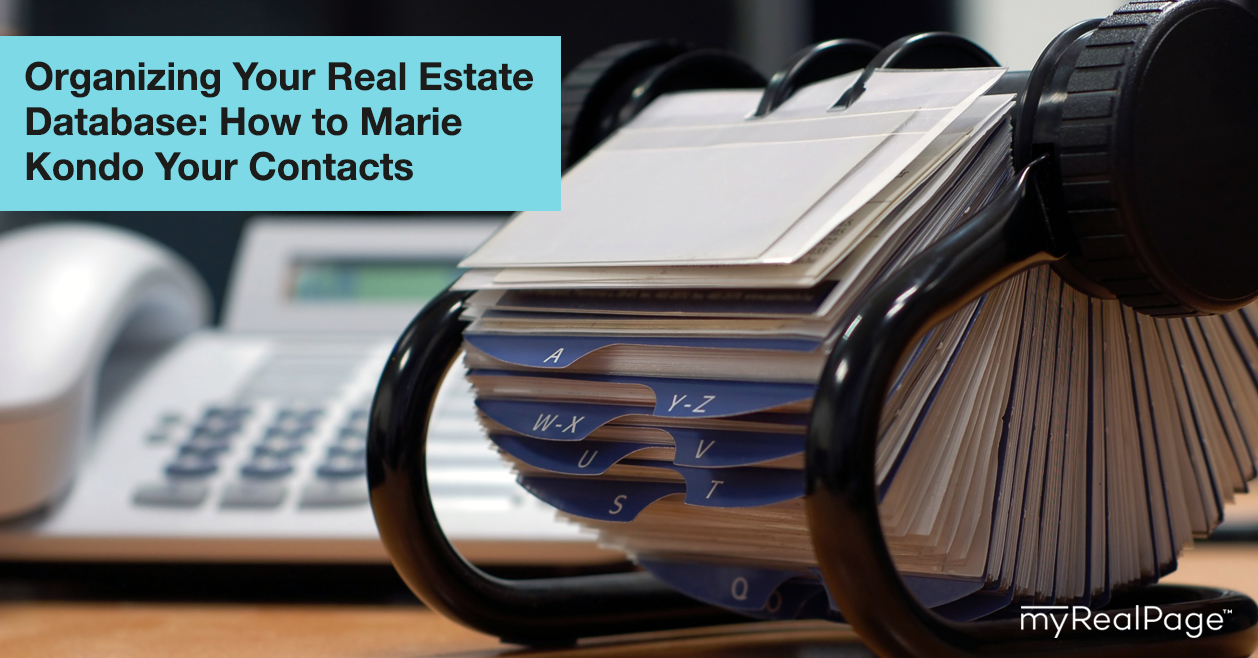Organizing Your Real Estate Database: How to Marie Kondo Your Contacts

Marie Kondo is a tidying expert whose book The Life-Changing Magic of Tidying Up, and recent Netflix series has made her and her KonMari method household names.
Her philosophy boils down to this: by paring down our belongings to only the things we need and the things that spark joy, we make our lives simpler and less stressful.
And what does that have to do with your real estate business?
Well, if you’re like most agents, your real estate database could probably benefit from Marie Kondo’s approach.
Without regular maintenance, databases become less effective. Instead of strategic tools, they become cluttered closets.
Phone numbers and addresses change. Relevancy declines. Deciphering between useful contacts and useless contacts becomes harder to do.
If it’s been years since you last Marie Kondo-ed your real estate database — or if you’ve never done it 😳— it’s time to dive in.
Here’s our guide to organizing your real estate database.
Why It’s Essential to Regularly Update Your Real Estate Database
A contact database is one of your most important assets as a real estate agent. It’s key to unlocking new business.
Busy agents are always adding more entries to their database. But without regular maintenance, it becomes harder to find who and what you’re looking for. You start running into frustrating issues, like:
- An ever-growing number of bounce-backs every time you send an email campaign
- Missing, messy, or incorrect data fields
- Duplicate entries
- Difficulty sorting contacts in lists that make sense
All these issues can be avoided by diving into your real estate database and embarking on a clean-up mission.
How Often Should You Organize Your Real Estate Database?
Tidying up your database becomes more difficult and more annoying the longer you avoid it. For most agents, an annual organizing spree should suffice.
Some of the work can be done on an ongoing basis. When you know a contact’s situation has changed or will change — they’re moving across the country, for example — add that detail as a note in your database entry for that particular person.
Or when a contact lets you know about a change of address or phone number, either update their database entry immediately, pass the task over to your marketing assistant or make a note to do it later that same day.
Steps to Cleaning Up Your Real Estate Database
We hear you. It can be overwhelming. Here’s how to go about organizing your real estate database, in 10 steps.
You can tailor these steps based on your particular system for storing contacts, and based on how organized (or disorganized) your database is.
• Set aside time.
This is a task you don’t want to rush. Set aside a half or full day to get it done. Block it off in your calendar.
• Take a deep breath.
You’ve got this.
• Create a spreadsheet.
An Excel (or Google) spreadsheet is the easiest way to organize your contacts. All CRMs and email marketing platforms accept uploads of spreadsheets, which they can then pull information from.
Create a set of fields in your spreadsheet for various kinds of information. Name, email address, cell phone number, landline number, and mailing address are the obvious fields. Fields for recording notes, such as personal details and insights, and for recording how you met are also recommended.
You may also want to create fields for noting whether the contact is a past or current client, a referral, interested in buying or selling, and what your last communication with them was.
• Amalgamate your lists.
If your database lives in many places – like a CRM, spreadsheets, an email marketing tool, and your phone – download and combine them.
• Look for duplicates.
A simple search in your spreadsheet will reveal duplicate entries (this can also be done in your CRM or email marketing platform) that you can then address.
• Look for errors.
Spelling errors, factual errors, information you know is outdated, details sitting in the wrong field, etc. Mistakes, big and small, can give you grief later on.
• Don’t be afraid to delete.
If you had a bad experience with a client or you have a lead who you personally can’t stand, just remove them. Take a cue from Ms. Kondo: if they don’t spark joy, get rid of them.
• Edit for consistency.
Make sure names and titles are capitalized properly and consistently, and that you’re being consistent about the type and depth of detail you record for each contact.
• Create sub-lists.
When you’ve finished organizing and editing your spreadsheet, save it. This is your master list.
Then, make a duplicate, and begin dividing it into sub-lists according to attributes such as location, past clients, close relationships, casual relationships, professional connections, referrals, buyers, sellers, and etcetera.
These sub-lists are a game-changer when it comes to sending real estate email campaigns and real estate postcards, tailoring your interactions, and simply finding the right contact in a big database.
• Save and upload.
When your master list and sub-lists are complete, save them and upload them to whichever tools you use.
What tool(s) do you use to store your real estate contacts? Let us know in a comment below.
Last Updated on June 27, 2024 by myRealPage


